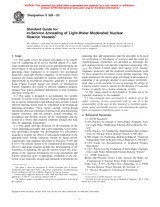Potrebujeme váš súhlas na využitie jednotlivých dát, aby sa vám okrem iného mohli ukazovať informácie týkajúce sa vašich záujmov. Súhlas udelíte kliknutím na tlačidlo „OK“.
ASTM E509-03
Standard Guide for In-Service Annealing of Light-Water Cooled Nuclear Reactor Vessels
Automaticky preložený názov:
Štandardné príručka pre In - Service Žíhanie Light - vodou chladených jadrových reaktorov nádob
NORMA vydaná dňa 10.3.2003
Informácie o norme:
Označenie normy: ASTM E509-03
Poznámka: NEPLATNÁ
Dátum vydania normy: 10.3.2003
Kód tovaru: NS-47030
Počet strán: 11
Približná hmotnosť: 33 g (0.07 libier)
Krajina: Americká technická norma
Kategória: Technické normy ASTM
Anotácia textu normy ASTM E509-03 :
Keywords:
fracture toughness, irradiation, nuclear reactor vessels (light-water cooled), radiation exposure, surveillance (of nuclear reactor vessels), ICS Number Code 27.120.10 (Reactor engineering)
Doplňujúce informácie
| 1. Scope | ||||||||||||||
|
1.1 This guide covers the general procedures to be considered for conducting an in-service thermal anneal of a light-water moderated nuclear reactor vessel and demonstrating the effectiveness of the procedure. The purpose of this in-service annealing (heat treatment) is to improve the mechanical properties, especially fracture toughness, of the reactor vessel materials previously degraded by neutron embrittlement. The improvement in mechanical properties generally is assessed using Charpy V-notch impact test results, or alternatively, fracture toughness test results or inferred toughness property changes from tensile, hardness, indentation, or other miniature specimen testing (1). 1.2 This guide is designed to accommodate the variable response of reactor-vessel materials in post-irradiation annealing at various temperatures and different time periods. Certain inherent limiting factors must be considered in developing an annealing procedure. These factors include system-design limitations; physical constraints resulting from attached piping, support structures, and the primary system shielding; the mechanical and thermal stresses in the components and the system as a whole; and, material condition changes that may limit the annealing temperature. 1.3 This guide provides direction for development of the vessel annealing procedure and a post-annealing vessel radiation surveillance program. The development of a surveillance program to monitor the effects of subsequent irradiation of the annealed-vessel beltline materials should be based on the requirements and guidance described in Practices E 185 and E 2215. The primary factors to be considered in developing an effective annealing program include the determination of the feasibility of annealing the specific reactor vessel; the availability of the required information on vessel mechanical and fracture properties prior to annealing; evaluation of the particular vessel materials, design, and operation to determine the annealing time and temperature; and, the procedure to be used for verification of the degree of recovery and the trend for reembrittlement. Guidelines are provided to determine the post-anneal reference nil-ductility transition temperature (RTNDT), the Charpy V-notch upper shelf energy level, fracture toughness properties, and the predicted reembrittlement trend for these properties for reactor vessel beltline materials. This guide emphasizes the need to plan well ahead in anticipation of annealing if an optimum amount of post-anneal reembrittlement data is to be available for use in assessing the ability of a nuclear reactor vessel to operate for the duration of its present license, or qualify for a license extension, or both. 1.4 The values stated in inch-pound or SI units are to be regarded separately as the standard. 1.5 This standard does not purport to address all of the safety concerns, if any, associated with its use. It is the responsibility of the user of this standard to establish appropriate safety and health practices and determine the applicability of regulatory limitations prior to use. |
||||||||||||||
| 2. Referenced Documents | ||||||||||||||
|
Odporúčame:
Aktualizácia technických noriem
Chcete mať istotu, že používate len platné technické normy?
Ponúkame Vám riešenie, ktoré Vám zaistí mesačný prehľad o aktuálnosti noriem, ktoré používate.
Chcete vedieť viac informácií ? Pozrite sa na túto stránku.




 Cookies
Cookies
